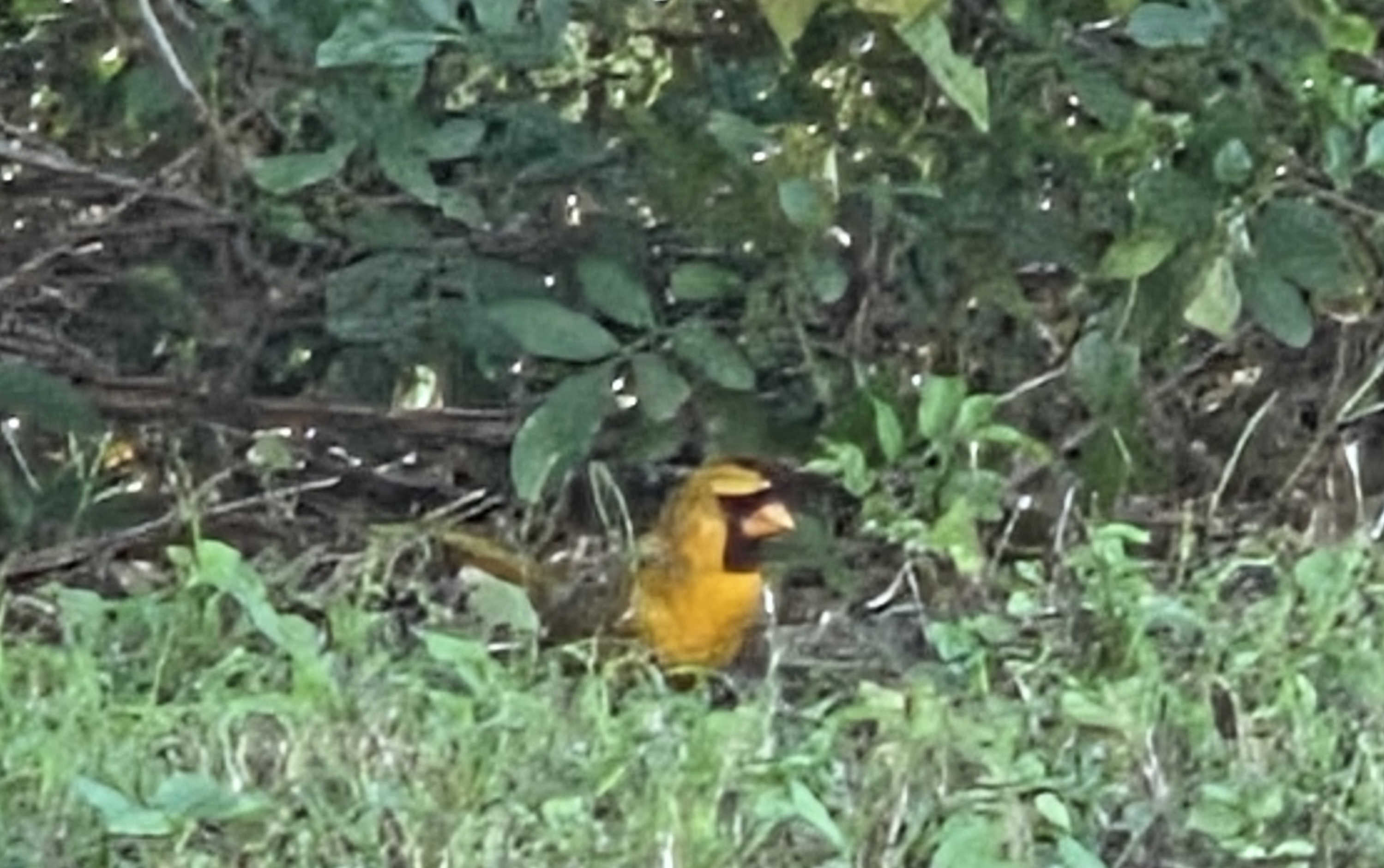
Photo by Dyane Oliva

Audio By Carbonatix
Even if you haven’t slipped down the birding rabbit hole that befalls many 30-somethings — yes, it’s coming for you too, Zoomers — you probably know what a cardinal looks like. It’s red, it’s got a thick beak, and there’s some black plumage in there, too. If you’ve seen a cardinal-looking bird that’s not bright red, you’ve likely spotted a female or juvenile, both of which are drab compared to their adult male counterparts.
But when Coral Springs resident Dyane Oliva spotted a cardinal-shaped “little yellow blob” in the grass while weeding in her backyard on Sunday, October 19, she knew something was off.
“I was like, ‘Oh, weird, must be an oriole,” she tells New Times, adding she’s used to interesting sightings during migration season at her home near Wiles Road and the Sawgrass Expressway. But she’d never seen anything like this.
She took her phone out for a closer look. “It’s got the little facemask that cardinals usually have. I’m like, ‘There’s no way this is a cardinal — it’s yellow! It’s as bright as a lemon!”
Miami, make your New Year’s Resolution Count!
We’re $16,000 away from our End-of-Year campaign goal, with just a five days left! We’re ready to deliver — but we need the resources to do it right. If Miami New Times matters to you, please contribute today to help us expand our current events coverage when it’s needed most.
But it sure looked like a cardinal. Remembering a viral story about an orange seagull that was thought to be a rarity but was later found to be simply covered in curry or turmeric, Oliva began to research online. An employee of Broward County’s Natural Resources Division, she knew enough about Florida wildlife to report the sighting to the Florida Ornithological Society and citizen science apps iNaturalist and eBird.
She also posted about the sighting on Reddit, where one user suggested she play the lottery this week. Until she saw the animated online response, she had no idea just how lucky she was to have a rare yellow cardinal show up in her backyard. “We do get kind of weird birds down here,” she says, “so I was just like, ‘Oh, a mutant!'”
A Rare Genetic Mutation
As it turns out, that’s pretty spot on. The yellow cardinal Oliva spotted likely has a genetic mutation called xanthochromism. Some birds — flamingos being one well-known example — get their color from their diet, explains Tropical Audubon Society president José Francisco Barros. “Cardinals also convert the food that they eat into pigments,” he says. “This seems to be a genetic mutation that doesn’t allow the red to become dominant, so the yellow becomes more dominant.”
Despite the anomaly, Barros says the Coral Springs yellow cardinal is likely otherwise unremarkable. “Might the yellow kind of throw him off as far as his surroundings? Maybe so, but as far as we know, they’re just as healthy as other birds,” he says.
It’s estimated that about one in a million Northern Cardinals are yellow. “Although not unheard of, it is a rare sighting,” he says. “There are only about three seen every year in the country, or in their range, which is mostly Eastern North America. Everyone knows the red cardinal, so the yellow one definitely is impressive and a sight that catches the eye of many people as something different.”
Past Sightings in Florida
Barros says he can’t think of any other yellow cardinal sightings this far south, nor by Tropical Audubon members. “Doesn’t mean it didn’t happen, but I don’t know of one.”
Still, there have been several sightings across the state in recent years. In 2023, Daytona News-Journal columnist Mark Lane wrote about spotting a yellow cardinal at his feeder. The previous year, Gainesville Sun photographer Brad McClenny captured images of another — nicknamed “Tweets” — in a wooded area at the University of Florida. (Barros has a friend who chased and photographed it.) Another yellow cardinal was spotted in Port St. Lucie in 2019, and in January 2020 — two months before pandemic lockdowns led to a global birding boom — two South Florida sightings were reported within minutes of each other.
Given the national interest other sightings have garnered, does Oliva worry about birders flocking (sorry) to her backyard?
“You know, Wiles Road, it’s this big stretch, and there’s a bunch of houses along it, so hopefully no one can narrow it down to be near my house,” she says. “I mean, people can go out there. It’s public property.”
Barros says she should prepare for some visitors, but not as many as other oddities might yield. “Would it attract as much [attention] as a South American vagrant or a Caribbean bird that makes its way up here? Maybe not as much, but it’s still a rarity, and I know there would be some people who would love to see this bird.”